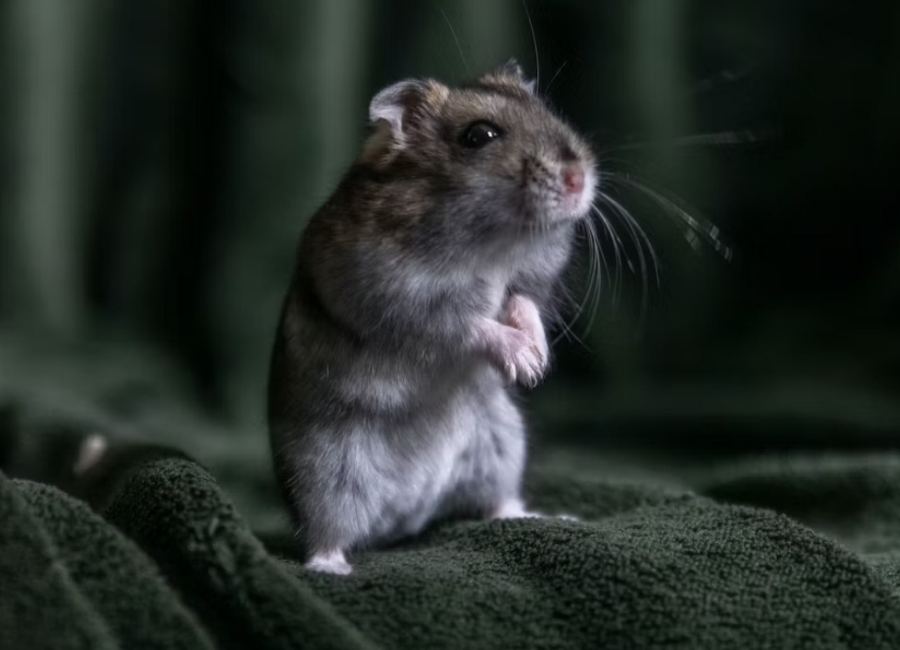28 Most Common Hamster Behaviors

Let’s discuss hamster behavior you should know…
If you’re as obsessed with all things furry and adorable as I am, you’ve probably found yourself wondering what goes on in your hamster’s little mind.
From their funny quirks to their adorable antics, these tiny creatures never cease to amaze us with their playful behavior.
So, in this blog post, we’re going to delve into the fascinating world of hamster behavior and discover what makes these little guys tick.
Are you ready to become a hamster expert? Let’s get started!
Hamster Behavior
The following are some of the most common hamster behavior and their meanings:
1. Burrowing
Burrowing activity is strongly embedded in the DNA of hamsters, who are natural burrowers.
They would excavate complicated tunnels and chambers in the wild to nest, hide from predators, and store food.
They still have the tendency to burrow and build warm nests in captivity.
By providing deep bedding material, such as aspen shavings or paper-based bedding, you allow them to engage in their natural habit while also making them feel safe in their surroundings.
2. Chewing
Due to their continually increasing teeth, hamsters have an insatiable desire to chew.
Chewing not only helps them keep their teeth clean, but it also allows them to investigate their environment.
They learn about their surroundings by nibbling on cage bars and items.
To fulfill their chewing needs while preventing dental issues, it is essential to give appropriate chew toys made of safe materials like wood or cardboard.
Learn more about hamster chewing behavior.
3. Running on a Wheel
When hamsters run on their exercise wheel, they accomplish several things.
Aside from being a cute sight to witness, this behavior is necessary for their physical and emotional well-being.
Hamsters have a lot of energy, and running on a wheel helps them burn it off, maintain muscular tone, and avoid obesity.
To protect their safety and comfort, give a properly sized wheel with little possibility of their back arching or tails becoming entangled.
4. Stuffing Cheeks
Hamsters’ ability to cram their inflatable cheek pouches with food is one of their most appealing traits.
They transport food back to their nests or storage sites, ensuring a steady supply of sustenance.
This is an innate tendency that stems from their wild ancestors’ need to collect and store food during times of shortage.
Seeing their lovely cheeks bulge with food demonstrates their ingenuity and survival instincts.
5. Scent Marking
Hamsters have smell glands all throughout their body, especially on their sides and chins.
They brush against things or surfaces to mark their territory with these glands.
They send signals to other hamsters by leaving their smell behind, establishing boundaries, and marking their presence.
Scent marking allows hamsters to build a familiar habitat and avoid confrontations with cage mates.
6. Grooming
Hamsters are extremely clean animals that spend a lot of time grooming themselves.
They painstakingly groom their fur with their little paws and swift tongues, eliminating dirt, excess oil, and parasites.
Grooming is not only necessary for preserving bodily hygiene, but it also aids to develop social relationships.
Hamsters groom one another in groups, assisting each other in reaching difficult-to-clean regions and establishing a sense of togetherness.
7. Hiding
Hamsters are skilled at locating warm hiding places within their environment.
When they wish to be alone or are anxious, they take sanctuary in these hiding spots.
Having safe havens in their cage, such as little dwellings or tunnels, gives them a sense of security and allows them to return to a protected location anytime they need a break from the outside world or prefer isolation.
8. Biting
While hamsters are typically friendly animals, they can bite in specific circumstances.
Biting can occur when they feel threatened, terrified, or surprised. It is critical to treat them with care and to respect their personal space.
Biting may sometimes be a symptom of discomfort or suffering, so paying attention to their body language and obtaining veterinarian help if the habit persists is critical for their well-being.
Learn more about hamster biting behavior.
9. Nesting
Nesting is an innate action that is most noticeable in pregnant or nursing female hamsters waiting for the birth of their young.
To build cozy nests, they gather soft bedding materials such as shredded tissues, paper strips, or nesting fluff.
These nests provide a warm and secure shelter for the young and demonstrate female hamsters’ maternal tendencies.
10. Exploring
Hamsters have an intrinsic curiosity that leads them to investigate their surroundings.
They have a keen sense of smell and keen vision, which they use to study new items, textures, and places in their environment.
Encouraging their natural curiosity by providing new toys, and tunnels, or modifying their cage layout stimulates their thoughts and keeps them from becoming bored.
11. Sleep Patterns
Hamsters are nocturnal creatures, which means they are most active at night.
Their sleeping patterns might be unpredictable, and it’s not uncommon for them to take brief naps throughout the day.
Respecting their natural circadian rhythm by providing a calm and dark atmosphere during their sleeping hours ensures they receive enough rest and contributes to their general well-being.
12. Freezing
Hamsters may freeze in place if they perceive danger or are frightened.
This is an instinctive protective strategy that assists them in avoiding discovery by prospective predators.
They blend into their environment by remaining completely motionless and depending on their outstanding camouflage talents.
Making your hamster’s habitat calm and quiet lowers incidences of freezing and helps them feel secure.
13. Climbing
Despite their diminutive size, hamsters have exceptional climbing ability. They can scale cage bars, ropes, and other vertical structures with ease.
Climbing acts as both exercise and a technique for exploring their surroundings from various perspectives.
Providing secure climbing possibilities, such as branches or ladders, helps them to engage in this natural habit while also adding diversity to their environment.
14. Nibbling on Bars
While hamsters nibble on cage bars to keep their teeth clean, excessive nibbling might indicate dissatisfaction, boredom, or a need for attention.
To prevent excessive bar-biting habits, ensure that their cage is suitably sized, and well-enriched and that they receive regular mental and physical stimulation.
15. Squeaking
Hamsters communicate through a variety of vocalizations, with squeaking being one of the most common.
A high-pitched squeak might indicate surprise, fright, pain, or discomfort.
It’s critical to listen to their voice signals since they can reveal their emotional condition or any potential health concerns.
Squeaking is their means of communicating with their owners or other hamsters.
16. Pouching
Hamsters have distinct cheek pouches that go all the way to their shoulders.
They use these expanding pouches to transport food, nesting material, or other materials from one site to another.
Pouching habit stems from their innate tendency to gather materials and store them for future use.
It’s amazing to watch hamsters fill their pouches and move stuff to their favored locations.
17. Scurrying
Hamsters are noted for their scurrying and rapid movements.
They move quickly and agilely, particularly while exploring or looking for food. Their scurrying indicates their vitality and attentiveness.
It’s interesting to observe their quick movements as they investigate and explore their environment.
18. Escaping
Hamsters are superb escape artists, and if given the opportunity, they will try to find a way out of their enclosures.
Their small stature and ability to fit through narrow openings enable them to flee.
To prevent escapes and maintain their safety, it is critical to provide a secure and adequately built cage or habitat.
19. Hamster Ball Rolling
Hamster balls are translucent spheres that allow hamsters to explore their surroundings while keeping them safe.
When placed inside a hamster ball, they roll it around with their paws.
This activity gives your hamster exercise, mental stimulation, and a change of environment.
It is critical to monitor their time in the ball to ensure they do not face any risks or become trapped in tight spots.
20. Squealing
Hamsters may squeal in response to pain, fear, or sorrow.
It’s a strong vocal expression that implies a great deal of distress.
If your hamster squeals, you must examine the situation and either offer proper treatment or eliminate any potential causes of injury.
21. Exploring with Whiskers
Hamsters have long, sensitive whiskers that let them perceive their surroundings.
They utilize their whiskers to investigate their surroundings, navigate in low-light circumstances, and sense environmental changes.
When your hamster is studying new items or strange surroundings, you may see them moving their whiskers forward and backward.
22. Rearranging Cage
Hamsters are known to alter their cages by shifting furniture, nesting material, or even excavating new tunnels.
This conduct helps people to construct the atmosphere they want and communicate their personal preferences.
It’s fascinating to watch how they arrange their home to accommodate their comfort and demands.
23. Chattering
By rapidly grinding their teeth together, hamsters may produce chattering noises.
When they are enthusiastic, irritated, or feel threatened, they may chatter. It’s a red flag indicating they’re nervous or defensive.
If you see chattering, give your hamster some space and discover any potential sources of stress.
24. Stretching
Hamsters, like humans, stretch their bodies to release stress and preserve flexibility.
Stretching is a natural practice that helps them maintain muscular limberness and readiness for exercise.
It’s usual to witness hamsters stretching their legs, arching their backs, or extending their bodies to their maximum length.
25. Popcorning
Popcorning is a common habit in young hamsters or when they are overjoyed or stimulated.
It features sudden hops and twists in the air, similar to popcorn popping. This joyous conduct is a sign of their enthusiasm for life.
26. Play-fighting
Play-fighting activity among cage mates is common in multi-hamster families.
Gentle wrestling, chasing, and mimic biting are all part of play fighting.
It assists youngsters in forming social ties, practicing coordination, and engaging in interactive play.
27. Standing on Hind Legs
Hamsters will occasionally stand on their hind legs to acquire a better view of their environment.
This habit enables them to detect possible risks and examine unusual sights or noises in their surroundings.
28. Hibernation
Hamster hibernation is a common behavior exhibited by several species of hamsters.
During hibernation, hamsters enter a state of torpor, which is characterized by a significant reduction in body temperature, heart rate, and metabolism.
This state allows the hamsters to conserve energy during the winter months when food is scarce and temperatures are low.
Hibernation also allows hamsters to avoid predators and reduce their risk of exposure to harsh weather conditions.
However, not all hamsters hibernate, and the duration and intensity of hibernation can vary depending on several factors such as sex, age, and food availability.
Hibernation in hamsters is an adaptive strategy that allows these animals to survive in challenging environments, and understanding its mechanisms can shed light on the physiological and behavioral adaptations of small mammals to changing environmental conditions.
Conclusion
In conclusion, hamsters are fascinating creatures with unique behaviors.
They are intelligent, playful, and social animals that can bring joy and happiness to any home.
Whether you’re watching them snuggle up in their cozy bed or run around in their exercise wheel, there’s no denying that hamsters are truly amazing pets.
So the next time you see your furry friend doing something unusual, remember that it’s just their natural behavior and embrace their quirks and cuteness!
